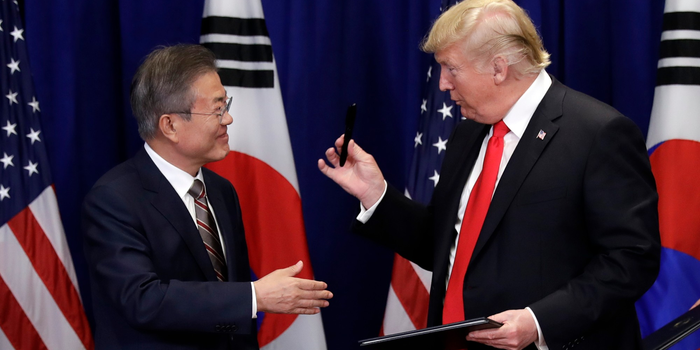U.S. and South Korea Finalize Trade Deal with 15% Tariffs, $350 Billion Investment Agreement
U.S. and South Korea Finalize Trade Deal with 15% Tariffs, $350 Billion Investment Agreement
By
Leah Rosenfeld
Last updated:
July 31, 2025
First Published:
August 6, 2025

Photo: Business Insider
Washington and Seoul Reach Major Trade Agreement Amid Rising Economic Stakes
In a sweeping new trade agreement, the United States and South Korea have finalized a deal to impose a 15% tariff on South Korean exports to the U.S., significantly lower than the 25% previously threatened by President Donald Trump.
The announcement comes just weeks after a similar trade pact between the U.S. and Japan, raising the pressure on Seoul to secure favorable terms and protect its economic interests in the American market.
$350 Billion Investment Commitment Sparks Conflicting Interpretations
One of the most striking elements of the deal is South Korea’s $350 billion investment pledge, which U.S. President Trump framed as money “owned and controlled by the United States, and selected by myself.”
However, South Korean President Lee Jae-myung presented a different interpretation. In a public Facebook post, he stated that the fund is intended to facilitate Korean corporate expansion into U.S. industries such as semiconductors, shipbuilding, batteries, biotechnology, and clean energy.
- $150 billion is earmarked specifically for “shipbuilding cooperation,” according to Lee.
- He emphasized the need for mutually beneficial results, rather than one-sided gains.
Dispute Over Profit Sharing and Control
The agreement echoes a prior U.S.-Japan trade deal, in which Tokyo is also contributing hundreds of billions in U.S.-based investments. In both cases, Washington has claimed that the lion’s share of the profits—up to 90%—will benefit the American public.
That claim has raised eyebrows in both Tokyo and Seoul. According to Reuters, Japan has already challenged how profits from its $550 billion investment will be divided, and experts expect similar tensions around South Korea’s contribution.
Strategic Context and Diplomatic Pressure
Trade analysts say South Korea had limited room to negotiate after the Japan-U.S. agreement. Wendy Cutler, former U.S. trade representative, noted that Korea moved swiftly to secure a deal “so as not to be disadvantaged in the U.S. market.”
Cutler added that while Seoul resisted opening up sensitive agricultural sectors like beef and rice, it failed to secure meaningful concessions in steel and semiconductor sectors, both of which remain exposed to future tariff escalations.
Trump also announced that South Korea will purchase $100 billion worth of U.S. LNG and other energy products, adding to the growing scale of economic engagement between the two countries.
No Tariffs on U.S. Goods, Despite Active FTA
In a controversial move, Trump said U.S. goods will face zero tariffs under the new deal, even though the two countries have maintained a bilateral Free Trade Agreement (FTA) since 2012, which had already eliminated most tariffs.
South Korea’s effective tariff rate for U.S. imports was just 0.79% as of 2024. Analysts say the new deal diminishes the value of the existing FTA, offering the U.S. unilateral advantages while providing little reciprocal benefit.
According to U.S. trade data, goods trade with South Korea totaled $197 billion in 2024, with the U.S. trade deficit rising 29.2% year-over-year to $66 billion.
Korean President Emphasizes National Interests
President Lee said the agreement will strengthen industrial cooperation and deepen the U.S.-Korea alliance. However, he reiterated that Korea would continue a “diplomacy centered on national interest” and push back against excessive external pressure.
On sensitive industries, U.S. Commerce Secretary Howard Lutnick confirmed that steel, aluminum, and copper are excluded from the current deal and will still face up to 50% tariffs as applied across nations.
Lutnick also stated South Korea would not be treated worse than other nations in critical areas such as semiconductors and pharmaceuticals, but uncertainty remains.
Financial Markets React Cautiously
Following the announcement:
- South Korea’s KOSPI index rose by 0.5%, reflecting mild investor optimism.
- Yields on 10-year Korean government bonds ticked slightly higher, indicating a cautious outlook on the fiscal impact.
Louise Loo, head of Asia economics at Oxford Economics, said that locking in a 15% tariff for South Korean autos may be seen as a partial win, but warned that tariffs on electronics and semiconductors could still be escalated down the line.
A Deal with Big Numbers and Bigger Questions
While the U.S.-South Korea trade agreement appears to stabilize immediate tensions, it introduces new ambiguities around investment control, profit allocation, and long-term equity. As South Korean firms prepare to expand across American industries under this deal, policymakers and observers alike are watching closely for the next steps—especially ahead of President Lee’s expected summit in Washington in the coming weeks.
Popular articles
Subscribe to unlock premium content
Disney’s Timeless Magic and How the Entertainment Giant Continues to Shape Culture and Innovation

Imran Khan’s Economic Missteps Amid Political Chaos in Pakistan

The Philippines’ Digital Shift How Remittances and BPO Are Fueling Growth

Disney’s Timeless Magic and How the Entertainment Giant Continues to Shape Culture and Innovation

Imran Khan’s Economic Missteps Amid Political Chaos in Pakistan

Disney’s Timeless Magic and How the Entertainment Giant Continues to Shape Culture and Innovation









